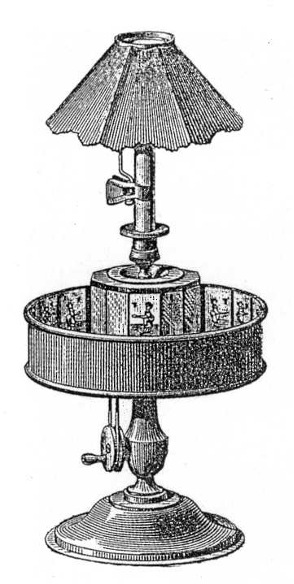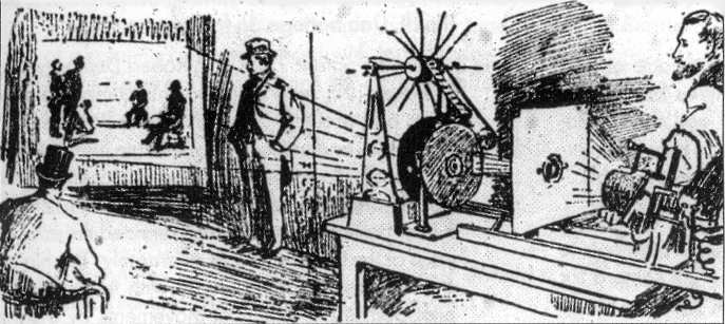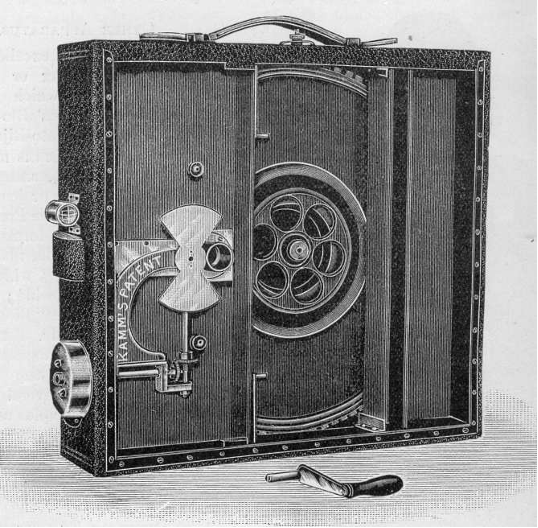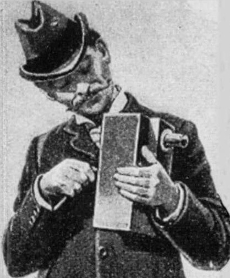Silents are golden: eidoloscopes, praxinoscopes and other (very) early cinematic inventions
The invention of the cinema was a fast-paced race. From the late 19th century onwards, dozens of inventors worked on machines to create moving images, from toys with optical illusions to cameras and projectors. Some of these machines, like Edison’s Kinetoscope, were essentially wood and brass versions of well-known modern projectors. But many other of these Victorian machines were, shall we say, different.
Whirling disks, moving slides, several lenses – there seemed to be an infinite number of possibilities for generating and projecting moving images, some inventions were more complicated than others. In the 1870s, Eadweard Muybridge got the ball rolling with his series of sequential photographs showing the movements of a running horse. This sparked an interest in other optical illusion novelties, and by the 1890s there were dozen of patents covering photographic equipment, each hoping to create the next big thing. Most of these unusual-looking inventions popped up in the 1890s, but some were even earlier. Here are some of those eccentric machines (Note: all pictures are from victorian-cinema.net, a fabulous and extremely detailed source of information on the very early cinema).
Zoopraxiskope
The aforementioned Muybridge created this particular projector from 1880 for public demonstrations of his sequential photographs. It had the same basic idea as the phenakistoscope and zoetrope, the early 19th century. swirling disks that generated animation: silhouettes were painted on a sheet of glass, and the spinning disk projected moving images onto a screen. Muybridge’s photos showing movement have been hugely influential, and some consider him the real father of cinema.
Praxinoscope

As the son of a watchmaker, Émile Reynaud was very familiar with unusual and fascinating inventions. Studying engineering and photography led to an interest in Magic Lantern slides and projectors. He decided to try his hand at developing an optical illusion toy, and the result was the Praxinoscope, with images on the inside of a circular band reflected in mirrors covering a central drum. As the tape turned, an animated image appeared in the mirrors. The success of his praxinoscope prompted Reynaud to …
Théâtre Optique

This was a large format praxinoscope with a projector and two coils that fed long strips of image around the circular ribbon so the animation wasn’t limited to what Reynaud could fit in a single circle. Each spool was hand cranked at the same time to do the animations. The pictures were printed on gelatin and affixed with fabric or leather, and it is believed that Reynaud was the first to use sprockets to move the pictures around. Reynaud began demonstrating his invention in 1892 and put on nearly 13,000 shows in less than ten years.
Electrotachyscope

This tall machine from 1886 was designed by the photographer Ottomar Anschütz, who became the photography advisor to the family of Kaiser Wilhelm II. It showed a large wheel made of glass pictures that was turned with a hand crank. The animation was viewed on a frosted glass screen in a darkened room just big enough to hold a handful of people. Anschütz’s invention was popular and smaller peephole versions appeared in fashionable cities like Paris and Berlin just before the similar (and slowly developed) kinetoscope emerged.
Tachyscope

Created by Anschütz in 1890, this was a longer version of a tachyscope that he created in 1887 (different from the electrical version in the last entry). It showed 4-6 picture bands around a closed cylinder. A tiny spark illuminated each image and the resulting moving images could be viewed through several small windows.
Cinéorama

After inventing several cumbersome combination cameras and projectors, the French inventor Raoul Grimoin-Sanson decided in 1897 to outdo himself and create a panoramic experience. He built ten cameras and projectors in a circle to turn the footage into a single panoramic image, and made several films, including an ambitious aerial shot from a balloon basket. While his invention was about to be exhibited at the 1900 World’s Fair in Paris, the heat of all those projector lamps kept them from working properly, and Grimoin-Sanson has since been forgotten (despite his attempts to claim that his cinema was working properly)).
Eidoloscope

In the mid-1890s, the Gray and Otway Latham brothers, along with their father Woodville and mechanic Eugene Lauste, patented what was probably the first film machine that produced a widescreen image (originally known as the Panoptikon). The brothers had been in the business of exhibiting films from prize competitions and determined to find a way to get life-size pictures. They made films on top of Madison Square Garden in New York City and used films that were five centimeters wide. While people were impressed by the enlarged images, the Lathams soon ran into legal and technical problems and eventually lost their patent. Her enduring legacy, however, is the “Latham Loop” – a limp loop of film that reduces tension on film and enables much longer moving images to be projected. Lauste is ascribed a large part of his development, as is Edison employee William K.-L. Dickson, who was a secret advisor.
Combatograph

Surprisingly, not all inventors switched from film equipment to film reels when it became available – some were still tinkering with other methods of film-making. In 1898 the Englishman Leonard Ulrich Kamm created a thin, 12-inch-wide sheet of glass on which the images were printed in a continuous spiral. Pictures could be captured by simply rotating the disc by hand in front of the lens. Advertised as a “filmless cinematograph”, guaranteed non-flammable like film, it was on the market for a few years, but didn’t last – the recordings took less than a minute and there was no way to edit them.
Many of these early cinematic inventions can now be found in museums and private collections, relics of an era of intense creativity and competition. While some once popular inventions have been forgotten and others only existed for a short time, they all contributed to the films as we know them today.

…
–Lea Stans for Classic Movie Hub
You can read all of the articles on Leas Silents are Golden here.
Lea Stans is a Minnesota born and raised Minnesota woman with a degree in English and an obsessive interest in the silent film era (largely attributing to Buster Keaton). Not only does she blog about her passion on her Silent-ology site, but she is also a columnist for them Quarterly silent film and has also written for The Keaton Chronicle.









